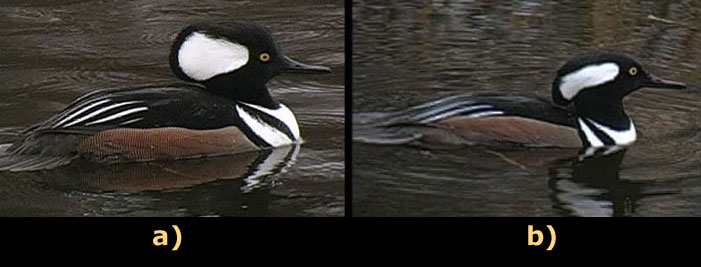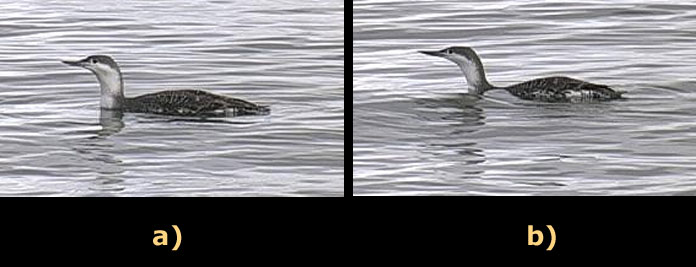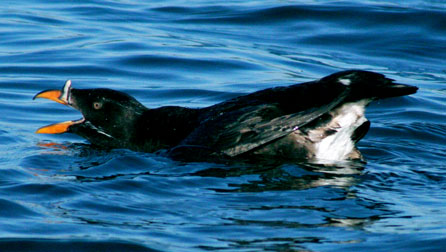
Watching Diving Birds:
The pull of buoyancy
Think of birds and you think of flight. Birds have evolved to be at home in the air and to soar the sky. Some birds, however, have returned to the sea to exploit the abundance of prey beneath the waves. Think of birds and you also think of light feathers and light bones; just the things that make it difficult to dive beneath the waves. Try to hold a balloon under water and you will have some idea of the work a bird must do to stay submerged. As much as 95% of the work performed by the hind limbs of some diving ducks is required to resist the pull of buoyancy. Diving birds have to deal with two major sources of buoyancy. The first is the air trapped in their plumage and the second is the air stored in the air sacs of their respiratory system. Air cavities create huge buoyant forces and make it harder for diving birds to stay submerged. Oxygen, however, is essential for a bird’s metabolism and tapped air in plumage provides insulation against the cold water. How then, do diving birds find a balance between these opposing constraints? How can they take the air they need while reducing buoyancy?
The feathers of diving birds perform the same function as the feathers of other birds. They provide insulation, repel wind and water, allow flight, and provide differences in colour and form. Feathers insulate by trapping air within a layered structure held in place by a system of barbules and hooklets (Figure 1). These elements, when properly aligned, also restrict the penetration of water. Although birds require oils from the preen gland to maintain and condition their feathers, the water repellency of plumage is the result of the tight association of barbules and hooklets. Birds can alter the amount of insulation provided by their plumage by adjusting the angle of the feather shaft. This process, called piloerection, increases the amount of air trapped between the layers of feathers. On cold winter mornings small birds can look almost spherical as they erect their plumage to create a thicker insulation layer.

Piloerection is also important to diving birds. As well as allowing them to control the thickness of their plumage, it also provides them with a way to reduce buoyancy. Diving birds adjust their buoyancy by compressing their plumage before they dive. It is common to see cormorants and loons adjust their buoyancy, sometimes sinking so that their backs hardly show above the surface, but other species of diving birds do this as well. By using digital video, I have recorded sequences showing that many other diving birds compress their feathers and adjust their buoyancy before diving. Hooded Mergansers not only compress their crest feathers, but they also compress their body plumage and settle deeper into the water. (Figure 2 & 3) At Swan Lake, careful observation of Pied-billed grebes will show the same behaviour.

Cormorants and anhingas have gone one step further than most diving birds. They have specially adapted wettable plumage which allows water to penetrate and thus reducing air-induced buoyancy. We often see cormorants perched with wings spread while drying their plumage. It was once thought that the wettable plumage was due to a lack of oil from the preen gland, however, it is now known to result from a structural characteristic of the feathers rather than a lack of oil. The cormorant’s and anhinga’s wing and body feathers are unique because their structure differs from other birds. In these feathers, some of the barbules are lacking hooklets so they are not as tightly bound to adjacent barbules. This structural feature is what allows water to penetrate the plumage. Near the base of the feathers, next to the body, the hooklets are again present and create a water resistant layer of insulation. Cormorants and anhingas benefit by having wettable plumage that reduces buoyancy while diving, but they suffer the cost of needing to dry their feathers afterwards.

The second major source of buoyancy results from a birds’ need to carry oxygen to power metabolism. Birds have an efficient respiratory system that includes lungs and 7 to 9 air sacs, some extending into hollow chambers in their bones. These air sacs, if filled to capacity, have the potential of creating large buoyant forces. They cannot dive without oxygen, but they need to mitigate the effect of buoyancy caused by storing oxygen in air spaces. To solve this problem, diving birds store oxygen within the blood, bound to the haemoglobin molecule, and also within the muscle cells, bound to the myoglobin molecule. Before diving, birds can hyperventilate to saturate their blood and tissues with oxygen and then exhale to reduce the volume of the air sacs. Alcids often display a “pre-dive posture” in which they hunch forward and sit for a moment with their bills open before they dive. (Figure 4) It is thought that these birds are hyperventilating to load oxygen stores and then exhaling to reduce air sac volume before diving. When they plunge below the surface, these birds have reduced their air sac volume and compressed their plumage in an effort to reduce buoyancy, while maintaining optimal oxygen stores and sufficient insulation from the cold water.

Watching birds is an enjoyable pastime well rewarded with sights of beautiful or rare species. For those interested in behaviour, birds can provide glimpses of fascinating behaviours that offer insights into how they live, feed, and reproduce. For the curious, watching birds can offer many challenges. We observe, then we wonder why and how. Why do mergansers drop their crest? Why do cormorants dry their wings? How do feathers keep birds dry? How do loons sink into the water?
